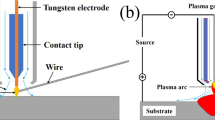The effect of post-welding heat treatment on the structure and properties of joints formed by laser welding from aluminum alloy AA2024 is studied. Tensile tests are conducted, x-ray phase analysis and electron microscopic analysis are performed; the Vickers microhardness is determined. It is shown that the weld metal and the heat-affected zone play a determining role in the operating capacity of the joints. The properties of the joints are raised by quenching and artificial aging. A heat treatment mode providing mechanical properties of joints from alloy AA2024 comparable to the properties of the base metal is suggested.










Similar content being viewed by others
Change history
27 February 2023
A Correction to this paper has been published: https://doi.org/10.1007/s11041-023-00860-y
References
X. Zhan, H. Yu, X. Feng, et al., “A comparative study on laser beam and electron beam welding of 5A06 aluminum alloy,” Mater. Res. Express, 6(5), 056563 (2019).
M. P. Chakravarthy, N. Ramanaiah, and B. S. K. Sundara Siva Rao, “Effect of laser welding on mechanical properties of 70/30 Cu – Ni alloy welds,” Proc. of the Institution of Mechanical Engineers, Part B, J. Eng. Manuf., 228(9), 1153 – 1161 (2014).
A. R. Sufizadeh, and S. A. Mousavi, “Investigation of Nd:YAG pulsed laser dissimilar welding of AISI 4340 and AISI 316L stainless steels on weld geometry and mechanical properties,” Mech. Industry, 18(5), Art. 512 (2017).
L.Wang, Y.Wei,W. Zhao, et al., “Effects of welding parameters on microstructures and mechanical properties of disk laser beam welded 2A14-T6 aluminum alloy joint,” J. Manuf. Process., 31, 240 – 246 (2018).
M. Vyskoè, M. Sahul, M. Dománková, et al., “The effect of process parameters on the microstructure and mechanical properties of AW5083 aluminum laser weld joints,” Metals, 10(11), Art. 1443 (2020).
X. Zhan, J. Zhou, W. Sun et al., “Effect of external applied steady magnetic field on the morphology of laser welding joint of 4-mm 2024 aluminum alloy,” Appl. Phys. A, 123(1), Art. 106 (2017).
P. I. Oliveira, J. M. Costa, and A. Loureiro, “Effect of laser beam welding parameters on morphology and strength of dissimilar AA2024/AA7075 T-joints,” J. Manuf. Proc., 35, 149 – 160 (2018).
M. Sheikhi, F. M. Ghaini, and H. Assadi, “Prediction of solidification cracking in pulsed laser welding of 2024 aluminum alloy,” Acta Mater., 82, 491 – 502 (2015).
B. Srinivas, N. M. Krishna, M. Cheepu, et al., “Studies on post weld heat treatment of dissimilar aluminum alloys by laser beam welding technique,” in: IOP Conf. Series, Mater. Sci. Eng., 330(1), Art. 012079 (2018).
K. S. Bal, J. D. Majumdar, and A. R. Choudhury, “Effect of post-weld heat treatment on the tensile strength of laser beam welded Hastelloy C-276 sheets at different heat inputs,” J. Manuf. Process., 37, 578 – 594 (2019).
S. Yu. Kondrat’ev, Yu. N. Morozova, Yu. A. Golubev et al., “Microstructure and mechanical properties of welds of Al – Mg – Si alloys after different modes of impulse friction stir welding,” Met. Sci. Heat Treat., 59(11 – 12), 697 – 702 (2018).
S. Yu. Kondrat’ev andO. V. Shvetsov, “Effect of high-temperature heating on the structure and properties of aluminum alloys in the production of drill pipes,” Met. Sci. Heat Treat., 55(3 – 4), 191 – 196 (2013).
L. Huang, D.Wu, X. Hua, et al., “Effect of the welding direction on the microstructural characterization in fiber laser-GMAW hybrid welding of 5083 aluminum alloy,” J. Manuf. Proc., 31, 514 – 522 (2018).
J. Ning, L.-J. Zhang, X.-Q. Yin, et al., “Mechanism study on the effects of power modulationon energy coupling efficiency in infrared laser welding of highly-reflective materials,” Mater. Des., 178, Art. 107871 (2019).
F. Caiazzo, V. Alfieri, F. Cardaropoli, et al., “Characterization of disk-laser dissimilar welding of titanium alloy Ti – 6Al – 4V to aluminum alloy 2024,” in: SPIE LASE, San Francisco, USA (2013), No. 8603.
S. Meco, G. Pardal, S. Ganguly, et al., “Application of laser in seam welding of dissimilar steel to aluminum joints for thick structural components,” Opt. Lasers Eng., 67, 22 – 30 (2015).
J. Blackburn, C. Allen, P. Hilton, and L. Li, “Nd:YAG laser welding of titanium alloys using a directed gas jet,” J. Laser Appl., 22, 71 – 78 (2010).
S. Chen, L. Li, Y. Chen, J. Dai, and J. Huang, “Improving interfacial reaction non homogeneity during laser welding-brazing aluminum to titanium,” Mater. Des., 32, 4408 – 4416 (2011).
V. Schultz, T. Seefeld, and F. Vollertsen, “Gap bridging ability in laser beam welding of thin aluminum sheets,” Int. Congr. Appl. Lasers Electro-Optics, 56, Art. 545 (2014).
K. Kalaiselvan, A. Elango, N. Nagarajan, and N. Mathiyazagan, “Studies on Ti/Al sheet joint using laser beam welding—AReview,” Int. J. Chem. Nucl. Mater. Metall. Eng., 8, 795 – 798 (2014).
S. Katayama, Y. Kawahito, and M. Mizutani, “Elucidation of laser welding phenomena and factors affecting weldpenetration and welding defects,” Phys. Proc., 5, 9 – 17 (2010).
M. Sahul, M. Sahul, M. Vyskoè, et al., “Disk laser weld brazing of AW5083 aluminum alloy with titanium Grade 2,” J. Mater. Eng. Perform., 26, 1346 – 1357 (2017).
M. Katsuna and Y. Qu, “Study on porosity formation in laser welds of aluminum alloys (Report 2) Mechanism of porosity formation by hydrogen and magnesium,” J. Light Met. Weld. Constr., 36, 1 – 17 (1998).
Author information
Authors and Affiliations
Corresponding author
Additional information
Translated from Metallovedenie i Termicheskaya Obrabotka Metallov, No. 10, pp. 29 – 38, October, 2022.
Rights and permissions
Springer Nature or its licensor (e.g. a society or other partner) holds exclusive rights to this article under a publishing agreement with the author(s) or other rightsholder(s); author self-archiving of the accepted manuscript version of this article is solely governed by the terms of such publishing agreement and applicable law.
About this article
Cite this article
Mallieswaran, K., Rajendran, C., Aravindhan, N. et al. Effect of Heat Treatment on the Structure and Properties of Laser Welded Joints of Aluminum Alloy AA2024. Met Sci Heat Treat 64, 564–572 (2023). https://doi.org/10.1007/s11041-023-00851-z
Received:
Published:
Issue Date:
DOI: https://doi.org/10.1007/s11041-023-00851-z




